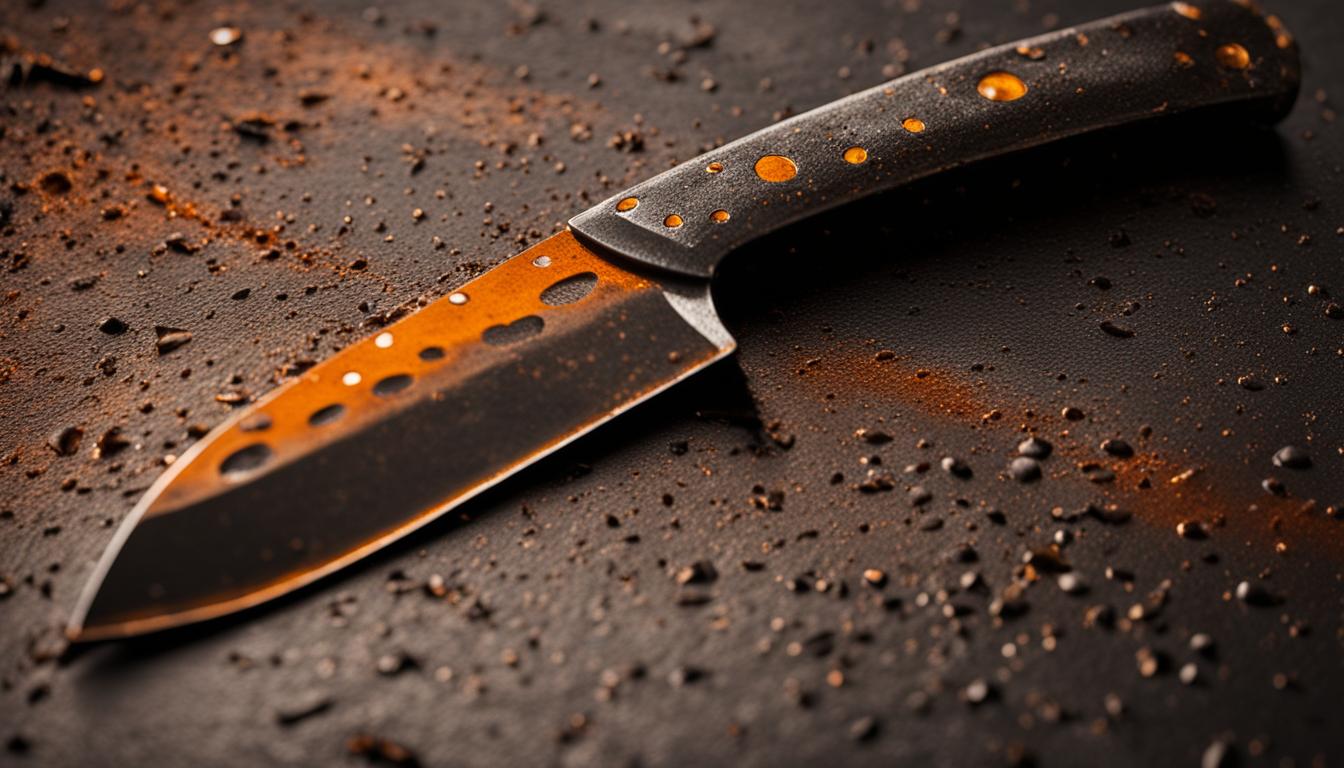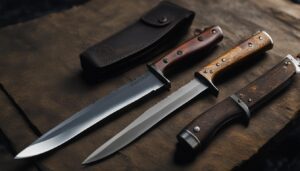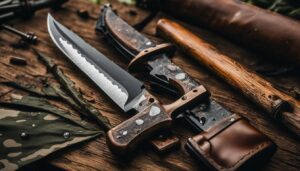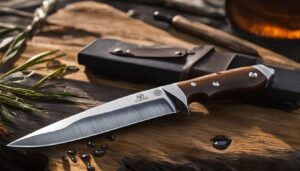In a survival situation, a hunting knife is a vital tool. However, over time, knives can develop surface rust due to regular use and exposure to corrosive materials. To prevent rust on your hunting knife, use a soft cutting surface, cut straight with little side to side movement, clean the blade immediately after cutting produce, and coat your knife with oil regularly. To revitalize a rusty hunting knife, you can sharpen it using a whetstone, honing steel, or strop. Proper maintenance and care will ensure your hunting knife remains in good condition for years to come.
Key Takeaways:
- Using a soft cutting surface and cutting straight can help prevent rust on your hunting knife.
- Clean the blade immediately after cutting produce to remove corrosive substances.
- Regularly coat your hunting knife with oil to protect it from rust.
- Sharpen your rusty hunting knife using a whetstone, honing steel, or strop.
- Proper maintenance and care are crucial for preserving the condition of your hunting knife.
The Importance of Properly Using Your Knife
Properly using your hunting knife is crucial for its maintenance and longevity. By following a few key practices, you can preserve the edge and sharpness of your knife blade for optimal performance.
1. Choose the Right Cutting Surface
Avoid using hard surfaces like granite or metal countertops when cutting with your hunting knife. Instead, opt for a soft cutting surface or a cutting mat. This helps prevent blunting and excessive wear on the blade, preserving its sharpness over time.
2. Cut with Minimal Side to Side Movement
When using your hunting knife, try to cut straight with minimal side to side movement. Excessive lateral motion can put unnecessary stress on the blade’s edge, leading to faster dulling. By cutting straight, you reduce wear and maintain the sharpness of your knife for longer.
3. Clean the Blade Immediately After Use
After cutting produce or other materials, make it a habit to clean the blade of your hunting knife immediately. Corrosive substances and food particles left on the blade can promote rust and corrosion. Simply wipe the blade with a clean cloth or rinse it under running water to remove any residue.
4. Test the Sharpness Regularly
To ensure your hunting knife remains sharp, periodically test its cutting ability. You can do this by cutting a piece of paper or shaving a patch of hair from your arm. If the knife struggles to cut effortlessly through the paper or hair, it may be time to sharpen the blade. A sharp knife not only performs better but also reduces the risk of accidents caused by slipping.
By following these practices, you can maintain the edge and sharpness of your hunting knife, allowing it to serve you well in various outdoor activities.
Sharpening Your Hunting Knife
Sharpening your hunting knife is an essential skill that every survivalist should master. Regular sharpening not only ensures optimal performance but also prolongs the lifespan of your knife. There are several methods you can use to sharpen your hunting knife, including using a whetstone, honing steel, and strop.
Using a Whetstone
A whetstone is a popular tool for sharpening hunting knives. It consists of a coarse and fine-grained surface, allowing you to remove material and refine the blade’s edge. To sharpen your knife with a whetstone:
- Place the whetstone on a stable surface and wet it with water or honing oil.
- Hold the knife at a 20-degree angle to the stone.
- Using gentle pressure, slide the blade across the stone in a controlled motion, moving from the base to the tip.
- Repeat this process several times on both sides of the blade, alternating between the coarse and fine-grained surfaces.
Honing Steel for Knife Sharpening
A honing steel is another tool that can help maintain the sharpness of your hunting knife. It is particularly useful for minor deformations or small imperfections in the blade. To use a honing steel:
- Hold the honing steel upright with the tip resting on a stable surface.
- Hold the knife at a 20-degree angle to the steel, with the base of the blade near the handle.
- Starting at the base, slide the blade down the steel, maintaining the angle and applying light pressure.
- Repeat this motion several times on both sides of the blade to realign the edge.
Remember to use caution when sharpening your hunting knife and always follow proper technique and safety guidelines. With regular sharpening and maintenance, your hunting knife will stay sharp and ready for any outdoor adventure.
Other Tips for Knife Maintenance
Proper maintenance and care are essential for keeping your hunting knife in optimal condition. In situations where sharpening materials are not readily available, there are alternative options you can use. For instance, a leather belt can serve as a makeshift strop for refining the blade’s edge. Additionally, if you don’t have access to a whetstone, you can use the top edge of a car window, an unglazed ceramic dish, or a smooth stone as substitutes.
When it comes to caring for stainless steel blades, regular rinsing with warm water and a gentle soap is recommended to remove dirt and debris. However, over time, salt marks may still appear on the blade. For carbon steel blades, wiping and oiling after each use are necessary to protect against oxidation. Some knife users even intentionally create a patina on their blades to reduce sensitivity to rust.
It’s important to note that different knives have varying sensitivities and care requirements based on their materials. By understanding and implementing these knife maintenance tips, you can ensure that your hunting knife remains in excellent condition, ready for any survival situation.
Table: Comparing Maintenance Tips for Stainless Steel and Carbon Steel Blades
| Stainless Steel Blades | Carbon Steel Blades | |
|---|---|---|
| Cleaning | Regular rinsing with warm water and gentle soap | Wiping with a cloth and oiling after each use |
| Rust Prevention | Rinse off salt and dry thoroughly | Regular wiping, oiling, and patina development |
| Corrosion Resistance | High | Lower compared to stainless steel |
| Resistance to Stains | Good | Susceptible to staining |
“Proper maintenance and care are the keys to ensuring the longevity and performance of your hunting knife.” – Survivalist Expert
By following these knife maintenance tips and understanding the specific requirements of your hunting knife, you can extend its lifespan and reliability. Whether you’re using a stainless steel or carbon steel blade, regular cleaning, oiling, and appropriate care will keep your knife ready for any outdoor adventure.
Caring for Your Hunting Knife: Essential Maintenance and Care Tips
When it comes to your hunting knife, proper care and maintenance are crucial to ensure its longevity and optimal performance. Whether you have a stainless steel or carbon steel blade, understanding the unique care requirements for each type is key. In this section, I will provide you with valuable insights and tips on how to care for your hunting knife to keep it in top condition.
Taking Care of Stainless Steel Blades
Stainless steel blades are known for their resistance to rust and corrosion, but they still require regular attention to preserve their quality. To care for a stainless steel hunting knife, start by rinsing it with warm water and using a gentle liquid soap to remove any dirt or debris. After washing, make sure to thoroughly dry the blade to prevent moisture from causing oxidation. Additionally, it’s recommended to apply a thin coat of oil to the blade to provide added protection against rust.
Maintaining Carbon Steel Blades
Carbon steel blades are more susceptible to rust and oxidation compared to stainless steel blades. To properly care for a carbon steel hunting knife, wipe it clean after each use to remove any moisture or residue. Applying a thin layer of oil is essential to create a barrier against oxidation. Carbon steel blades may also develop a natural patina over time, which can help reduce their sensitivity to rust. Regularly inspect your carbon steel blade for any signs of rust and address them promptly to prevent further damage.
| Caring for Stainless Steel Blades | Maintaining Carbon Steel Blades |
|---|---|
|
|
General Maintenance Tips
In addition to caring for the specific type of blade you have, there are some general maintenance tips that apply to all hunting knives. Avoid exposing your knife to extreme temperatures, as this can damage the handle and affect the blade’s performance. Keep your hunting knife stored in a dry area to minimize the risk of moisture buildup. Regularly inspect the knife for any loose or damaged components and address them promptly. Lastly, sharpen the blade as needed to maintain its cutting edge and overall effectiveness.
By following these maintenance and care tips, you can ensure that your hunting knife remains a reliable tool for your outdoor adventures. Whether you have a stainless steel or carbon steel blade, taking the time to properly care for your knife will help prolong its lifespan and keep it in optimal condition.
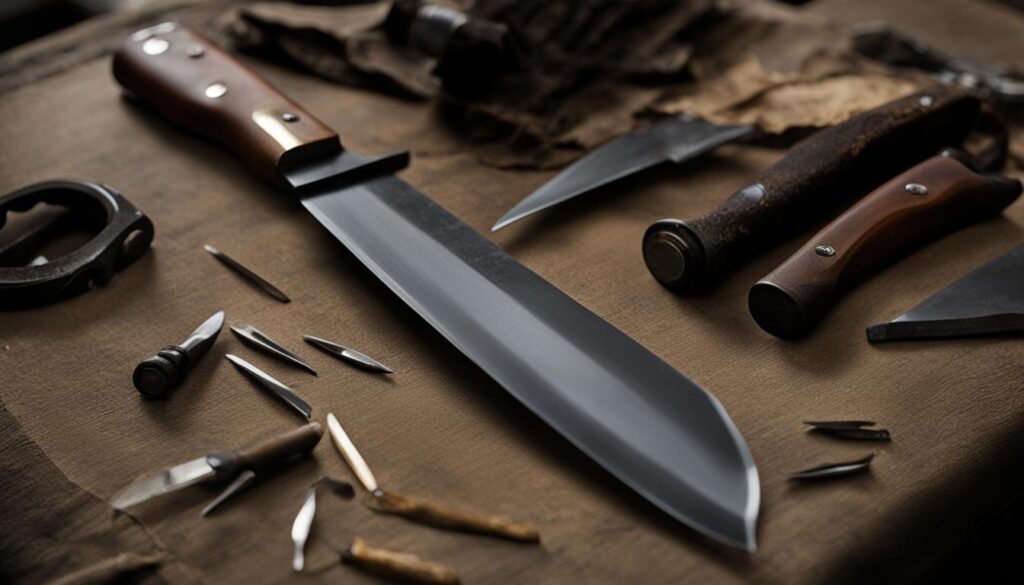
Stainless Steel Explained
Stainless steel knives are a popular choice among outdoor enthusiasts and survivalists due to their corrosion resistance. These knives are made with at least 11.5% chromium, which forms a protective oxide layer on the surface, preventing rust and corrosion. However, it is important to note that stainless steel knives are not completely immune to rust, despite their name. Regular cleaning, drying, and proper maintenance are essential to ensure the longevity of your stainless steel knife.
When it comes to cleaning your stainless steel knife, it is best to hand wash it using warm water and a mild liquid soap. Avoid using abrasive cleaners or scrub brushes, as they can scratch the surface of the blade. After washing, make sure to thoroughly dry the knife to prevent any moisture from lingering on the surface. Moisture, especially in humid or salty environments, can lead to the development of rust or pitting on the blade.
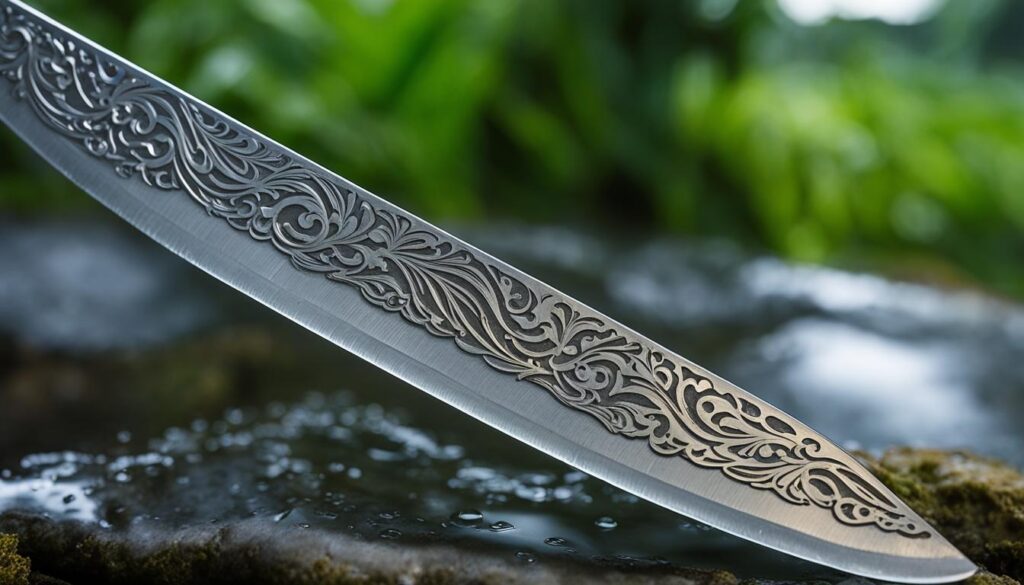

Another important aspect of maintaining your stainless steel knife is applying a thin coat of oil to the blade. This helps protect the knife from moisture and reduces the risk of oxidation. You can use a food-grade mineral oil, silicone-based oil, or even WD-40 as a protective coating. Apply the oil to a clean cloth and gently rub it onto the blade, making sure to cover the entire surface. This simple step can go a long way in preserving the quality and performance of your stainless steel knife.
It is worth noting that machine-washing stainless steel knives is not recommended. The harsh detergents used in dishwashers can be corrosive to the blade and handle, potentially causing damage. Additionally, sharp knives can pose a risk of injury to both yourself and others when placed in a dishwasher. To prolong the lifespan of your stainless steel knife, hand-washing and proper care are essential.
Conclusion
In conclusion, proper maintenance and care are essential for the prevention and revitalization of a hunting knife affected by surface rust. By following best practices such as using a soft cutting surface, cleaning the blade after each use, and regularly sharpening the knife, you can significantly extend the lifespan of your hunting knife.
Regardless of whether your hunting knife has a stainless steel or carbon steel blade, it’s crucial to understand the unique care requirements for each type. Stainless steel blades offer greater corrosion resistance but still require regular cleaning, drying, and oiling to prevent rust. Carbon steel blades, on the other hand, need wiping and oiling after every use to protect against oxidation.
By maintaining your hunting knife diligently, it will remain a reliable tool in survival situations for many years to come. Remember to prioritize its preservation by practicing the proper techniques and employing the necessary maintenance routines. With the right attention and care, your hunting knife will continue to serve you well throughout your adventures.
FAQ
How can I prevent rust on my hunting knife?
To prevent rust on your hunting knife, use a soft cutting surface, cut straight with little side to side movement, clean the blade immediately after cutting produce, and coat your knife with oil regularly.
How can I revitalize a rusty hunting knife?
To revitalize a rusty hunting knife, you can sharpen it using a whetstone, honing steel, or strop.
What is the importance of properly using my knife?
Properly using your hunting knife is essential for its maintenance and longevity. Use a soft cutting surface or mat, cut straight with minimal side to side movement, clean the blade immediately after cutting produce, and regularly coat high carbon blades with oil.
How do I sharpen a hunting knife?
Sharpening your hunting knife can be done using a whetstone, honing steel, or strop. Start with a coarse grit and then switch to a finer grit for a polished finish. Proper technique and maintenance of sharpening tools are crucial for effective knife sharpening.
What are some alternatives for sharpening materials?
In situations where sharpening materials are not readily available, you can use a leather belt as a strop. Various materials like the top edge of a car window, unglazed ceramic dish, or smooth stone can be substitutes for a whetstone.
How should I care for stainless steel blades?
For stainless steel blades, regular rinsing with warm water and gentle soap is recommended. Avoid machine-washing knives as dishwasher detergents can damage the blade. Proper maintenance and hand-washing will help preserve the quality of stainless steel knives.
How should I care for carbon steel blades?
Carbon steel blades require wiping and oiling after use to protect against oxidation. Some knife users even create a patina on their blades to reduce sensitivity. Regular maintenance and care are essential for preserving the quality of carbon steel blades.
How can I ensure the longevity of my hunting knife?
Taking good care of your hunting knife is essential for its longevity. Different knives have varying sensitivities, so understanding the unique care requirements for each type is crucial. With regular maintenance, your hunting knife will serve you well for years to come.
